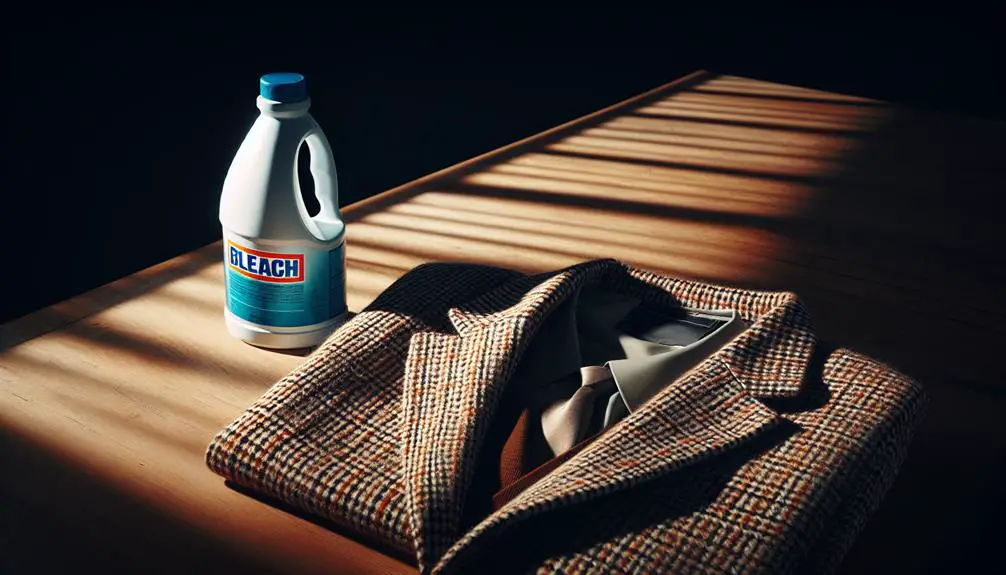I've always been curious about whether you can safely bleach tweed without ruining its unique texture and color. Considering tweed is typically made from wool, a material known for its sensitivity to harsh chemicals, the idea of bleaching it seems risky. Many folks love tweed for its durability and classic look, but what happens when it gets stained or starts to look a bit dingy? Is bleaching a viable option, or does it cause more harm than good? Let's explore some safer alternatives to keep our tweed looking sharp and see if there might be a way to lighten it without the damage. What do you think?
Table of Contents
Key Takeaways
- Bleaching tweed is not recommended as it can weaken the fabric's tightly woven wool fibers.
- Harsh chemicals in bleach can cause irreversible damage, altering texture and color stability.
- Safe alternatives include gentle washing methods and natural stain removers like vinegar or lemon juice.
- Dry cleaning is advised to maintain tweed's vibrant colors and structural integrity without the risks of bleaching.
- Always test any cleaning method on a small, inconspicuous area of the tweed garment first.
Understanding Tweed Fabric
Tweed is a durable, woolen fabric known for its rough texture and intricate weave patterns. Originating from Scotland and the north of England, this material earned its reputation primarily through its use in outdoor garments. The resilience and insulating properties of tweed make it ideal for tackling the unpredictable weather in these regions. It's not just about staying warm, though; the fabric's durability stems from tightly woven wool fibers that resist wear and tear, ensuring that a tweed jacket or trousers can handle a lot of rough treatment without showing much damage.
Understanding tweed's origins helps explain why it remains popular in contemporary fashion and functional attire. It was initially handwoven by locals, and its patterns and colors were influenced by the natural dyes available in the area, which also helped to camouflage wearers amongst the landscape. Today, while methods have modernized, the essence of tweed holds true to its roots with many still valuing its robustness and unique aesthetic.
For anyone looking to master the use of tweed, recognizing its inherent durability and historical significance is essential. This understanding not only aids in choosing the right tweed garments but also in caring for them properly.
Risks of Bleaching Tweed
Bleaching can seriously damage the intricate weave and natural fibers of tweed fabric. As someone who's been through the process, I'll tell you it's not straightforward. Bleaching affects not just the appearance but also the core characteristics of tweed, including its color stability and fabric integrity.
Here's what you might face if you decide to bleach tweed:
- Weakening of Fibers: The harsh chemicals in bleach can break down the natural fibers of tweed, leading to a weaker fabric that's prone to tearing.
- Loss of Color Stability: Tweed is known for its rich, varied hues. Bleaching can lead to uneven color loss, creating a patchy appearance that's far from the original look.
- Altered Texture: The texture of tweed is part of its charm. Bleaching can flatten the naturally nubby surface, leaving you with a fabric that feels different to the touch.
- Shrinkage: Heat and chemicals together? That's a recipe for shrinkage. The dimensions of your tweed item might change, and not for the better.
In short, if you're aiming to maintain the unique qualities of your tweed, bleaching should probably be a no-go. Think carefully about the effects before going down that route.
Common Bleaching Mistakes
Now, let's talk about the common errors people make when they try to bleach tweed. One major blunder I've noticed is the misuse of bleach types. Tweed, being a delicate fabric primarily composed of wool, reacts poorly to strong bleaches like chlorine. It's important to understand fabric compatibility before you start pouring bleach over your favorite jacket.
Another frequent mistake is not testing the bleach on a small, hidden area of the fabric first. You'd be surprised how many jump right in and end up ruining an entire piece. Always, always do a spot test.
Here's a quick table to recap these mistakes and add one more you might not have thought about:
| Mistake | Why It's a Problem |
|---|---|
| Using the wrong bleach type | Not all bleaches are suitable for tweed. |
| Skipping the spot test | You risk damaging the fabric unexpectedly. |
| Over-bleaching | Can weaken the tweed fibers drastically. |
Safe Cleaning Alternatives
So, let's switch gears and talk about some safer ways to clean your tweed.
I'll show you some gentle washing techniques that won't damage the fabric, and we'll explore how you can tackle stains naturally without harsh chemicals.
This way, you can keep your tweed looking great without risking any harm to the material.
Gentle Washing Techniques
To safely clean tweed without harsh chemicals, I prefer using mild detergent and cool water. It's important to handle this delicate fabric with care to maintain its texture and color. Here's a straightforward approach I've found incredibly effective:
- *Hand wash gently*: Agitating tweed too vigorously can damage its fibers.
- *Avoid wringing*: Squeeze out water gently; don't twist or wring the fabric.
- *Dry flat*: Lay the garment on a towel away from direct heat or sunlight.
- *Skip the dryer and fabric softeners*: These can degrade the fabric integrity. Instead, air dry and if needed, use a steamer for wrinkles.
Mastering these techniques ensures your tweed items last longer and stay in pristine condition.
Natural Stain Removal
One effective way to tackle stains on tweed is by using everyday pantry items like vinegar and baking soda. The vinegar effectiveness lies in its acidity, which breaks down both organic and inorganic substances, making it a champion at removing those stubborn marks.
I usually mix equal parts water and vinegar, apply it directly to the stain, and let it sit before gently blotting. For tougher stains, I make a paste with baking soda and a bit of water. After applying, I let it dry and then brush off.
Lemon application can also be a game-changer. The natural acid in lemon juice is great for lightening dark spots. Just dab a little on the stain, and voila! Safe and sound, all naturally cleaned.
Spot Cleaning Techniques
When dealing with spot stains on tweed, it's important to act quickly to prevent the stain from setting. I've found that treating spots without delay can save your tweed from permanent damage, keeping it looking impeccable for years.
First off, I start with dry brushing. A soft-bristled brush gently removes any loose particles on the fabric's surface. This is vital because it preps the area, making the next steps more effective. Next, I lightly vacuum the affected spot. Vacuum cleaning helps pull out any remaining dust and dirt, creating a clean slate for more targeted cleaning.
Here's a brief rundown on how I handle spot cleaning on my tweed garments:
- Blotting: Always blot, never rub. Use a clean, white cloth to dab the stain, absorbing as much of the spill as possible.
- Mild Detergent: Apply a small amount of mild detergent mixed with water. It's gentle yet effective.
- Rinse and Repeat: After applying detergent, blot again with a water-dampened cloth to remove soap residue.
- Air Dry: Let the fabric air dry completely. Heat from dryers or irons can set the stain permanently.
Preventing Tweed Discoloration
Before we get into bleaching, let's talk about how to keep your tweed looking great.
First, you've got to check if your tweed is colorfast to avoid any unwanted surprises.
Then, we'll go over the best ways to wash it and how to handle sun exposure to prevent fading.
Identify Colorfastness First
To prevent discoloration in tweed, you must first check if the fabric is colorfast. I always start with color testing, which helps me avoid any surprises later on. Here's how I guarantee the tweed's integrity isn't compromised:
- Dampen a small hidden area: This is your go-to for initial checks.
- Press a white cloth against it: If color transfers, it's a no-go.
- Use a mild soap solution: This simulates a gentler cleaning environment.
- Observe changes: Any fading or bleeding? That's your red flag.
Understanding fabric swatching is essential. It's not just about aesthetics; it's about preserving the quality of your tweed. Always test before you treat!
Proper Washing Techniques
I always make sure to use cold water and a gentle cycle when washing tweed to prevent any color loss. Tweed's unique texture and weave make it susceptible to damage, so I stick to these machine settings meticulously.
If the tag suggests, I opt for dry cleaning instead, as it's a safer bet for maintaining vibrant colors and structural integrity. It's important to avoid hot water and harsh cycles; they're surefire ways to mess up your tweed.
When I do use the washing machine, I always select a mild detergent designed for delicate fabrics. This approach guarantees my tweed garments stay pristine and colorful, without the risk of fading or wear from improper care.
Sun Exposure Management
Managing sun exposure is crucial for preventing tweed discoloration. We all know that tweed is both stylish and durable, but without proper care, it can fade quickly when exposed to direct sunlight. Here's how I handle it to maintain the vibrant colors:
- Shade Use: Always store your tweed garments in a shaded area. Direct sunlight can be harsh.
- UV Protection: Consider using UV-protective sprays that are safe for fabrics. These can add an extra layer of defense.
- Rotating Clothing: Rotate your wardrobe to make sure that the same piece isn't exposed to sunlight too frequently.
- Closet Management: Invest in good quality garment covers that block out light when storing your clothing.
These steps have seriously boosted my tweed game!
Choosing the Right Detergents
Why should you care about choosing the right detergent when bleaching tweed? Well, it's all about maintaining the fabric's integrity while achieving the desired whitening effect. Not all detergents are created equal, and some can be too harsh for delicate tweed fibers.
First up, let's talk about pH levels. Tweed thrives best with a detergent that has a neutral pH. Anything too acidic or too alkaline can damage the fibers, altering the texture and color. You'll want to pick a detergent labeled as pH-neutral to keep your tweed in top condition during the bleaching process.
Now, onto fabric softeners – they're a no-go. While it might be tempting to add fabric softeners to make your tweed feel softer post-wash, resist the urge. Fabric softeners can leave a coating that affects how the bleach interacts with the tweed, potentially leading to uneven bleaching or even damage. Stick to a simple, straightforward detergent without added softeners or other fancy additives.
Choosing the right detergent isn't just an important step; it's a vital step to make sure your tweed items are effectively and safely bleached. So, take your time, read those labels, and choose wisely!
Professional Cleaning Options
When it comes to bleaching tweed, I've found that sometimes it's best to leave it to the pros. Choosing expert cleaners who specialize in tweed can really make a difference.
They offer specialized treatments that keep your tweed looking its best.
Choosing Expert Cleaners
Selecting the right professional cleaning service is essential for maintaining your tweed's quality and appearance. When I hunt for a cleaner, I don't just look for any old service. Here's what really matters:
- Experience with Tweed: They must understand tweed's unique needs.
- Dryer Risks Awareness: Knowledge about avoiding high heat that can shrink or damage the fabric.
- Color Consultations: Expertise in advising on color preservation during the cleaning process.
- Reputation for Quality: Look for glowing reviews and recommendations from tweed enthusiasts.
Choosing a cleaner isn't just ticking a box; it's about ensuring your tweed stays in prime condition for years. I always take the time to check these details; it makes all the difference!
Specialized Tweed Treatments
Now, let's explore the specialized tweed treatments that professional cleaners offer. When it comes to maintaining the quality and longevity of your tweed, opting for professional services is a smart move. They've got the tools and expertise to handle tweed dyeing and enhance fabric resilience without compromising the integrity of the fabric.
Here's a quick guide on what services are typically available:
| Service Type | Description |
|---|---|
| Tweed Dyeing | Revitalize color with specialized dyes |
| Fabric Resilience | Reinforce fabric to resist wear |
| Stain Removal | Targeted techniques for tough stains |
These options help your tweed remains vibrant and durable. Trusting professionals means you're getting the best care possible for your beloved tweed garments.
Storing Tweed Properly
To keep your tweed in top condition, store it in a cool, dry place away from direct sunlight. Climate control is key; maintaining a consistent temperature and humidity level prevents the fabric from becoming damp or too dry, which can lead to damage. Pest prevention is equally important. Moths and other insects love to munch on natural fibers like tweed, so keeping them at bay is essential for preserving your garments.
Here's a quick breakdown of how I make sure my tweed stays pristine:
- Use cedar blocks or lavender sachets: These natural repellents keep pests away without the harsh chemicals.
- Avoid plastic covers: Instead, opt for breathable garment bags that allow air circulation but keep dust and dirt out.
- Regularly inspect your storage area: Check for signs of moisture or infestations. Early detection can save your tweed.
- Fold don't hang: Hanging tweed can stretch and misshape it. Fold your items with acid-free tissue paper to maintain their shape.
Revitalizing Faded Tweed
Revitalizing faded tweed can give your old garments a fresh, vibrant look. I've found that with the right techniques, you can breathe new life into that beloved jacket or skirt without compromising its unique texture. Let's delve into how color enhancement through fabric dyeing can transform your tweed.
First off, it's important to choose a dye that's compatible with tweed, which is typically made from wool. I recommend using acid dyes because they're great at bonding with wool fibers, ensuring your color enhancement is even and lasting. Before you start, always test the dye on a small, inconspicuous area of the fabric to make sure the color turns out how you want it.
When dyeing, keep the water temperature lukewarm to avoid shrinking or damaging the tweed. Stir gently and consistently to achieve an even color without splotches. After dyeing, rinse the garment until the water runs clear to remove any excess dye, then lay it flat to dry, avoiding direct sunlight.
Frequently Asked Questions
How Does Tweed React to Different Weather Conditions?
I've noticed tweed's moisture absorption makes it cozy in damp weather, but it's not great under heavy rain. Its sunlight resistance helps prevent fading, keeping those classic patterns vibrant even with exposure.
Can Tweed Be Dyed After Bleaching?
I've found that after bleaching tweed, its color retention can vary. Selecting the right dye choices is essential for even coverage. It's all about matching the dye type to the fabric's condition.
Are There Eco-Friendly Methods to Bleach Tweed?
Yes, there are eco-friendly methods to bleach tweed. I've explored natural lightening techniques and chemical alternatives that are less harsh on the fabric, providing effective results without compromising environmental integrity.
How Does Aging Affect Tweed Fabric Properties?
Aging typically causes tweed's color to fade and its texture to change. I've noticed that these effects can enhance the fabric's character, giving it a unique, vintage appeal that's highly valued.
Can Tweed Be Ironed Safely at Home?
I've found you can iron tweed at home safely with the right ironing tips. Just use low temperature settings and a pressing cloth to avoid scorching. It keeps your tweed looking sharp!
- How Does Ring Spun Cotton Affect Garment Fit and Shape Retention? - August 13, 2024
- What Are the Challenges in Producing Ring Spun Cotton? - August 13, 2024
- Is Ring Spun Cotton Suitable for Plus-Size Clothing? - August 13, 2024







